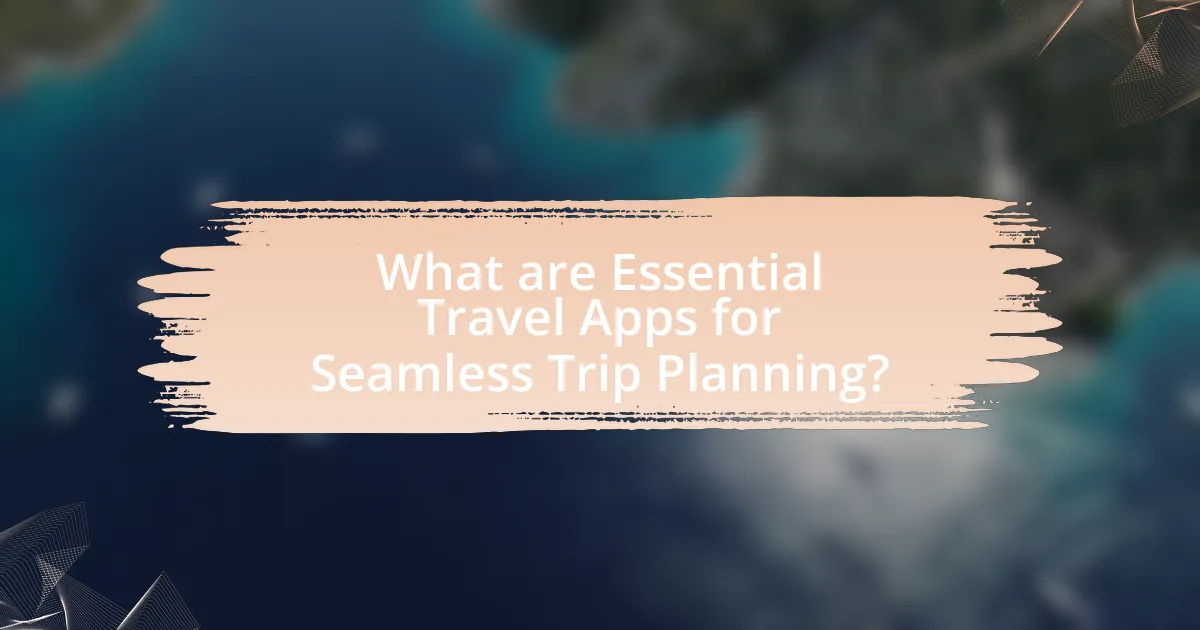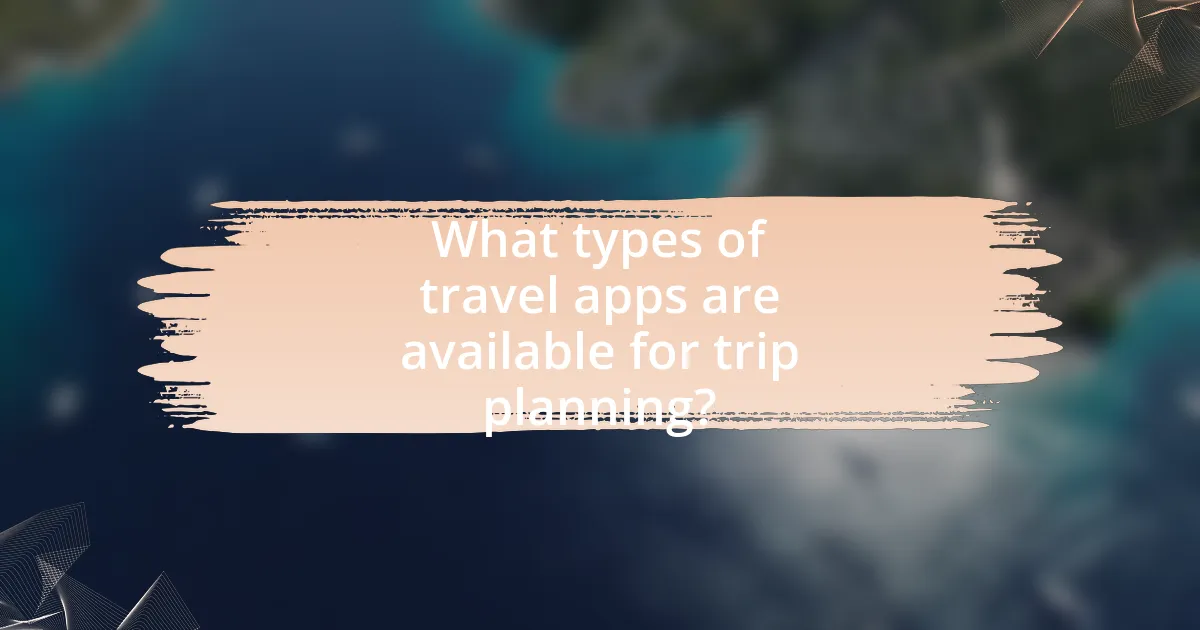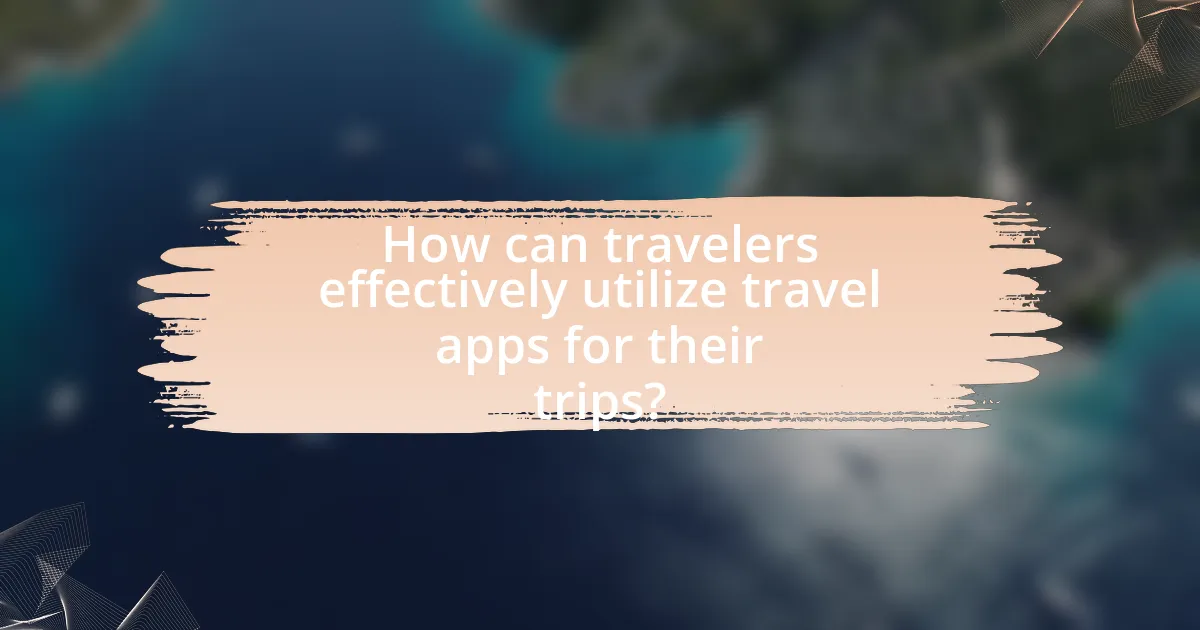Essential travel apps play a crucial role in facilitating seamless trip planning by providing users with tools for navigation, itinerary management, and booking services. Key applications such as Google Maps, TripIt, and Skyscanner enhance the travel experience by consolidating essential information and streamlining logistics. The article explores various types of travel apps, their features, and how they cater to different traveler needs, emphasizing the importance of using these digital solutions to improve organization, reduce stress, and enhance overall trip satisfaction. Additionally, it discusses best practices for effectively utilizing travel apps and troubleshooting tips to maximize their functionality.

What are Essential Travel Apps for Seamless Trip Planning?
Essential travel apps for seamless trip planning include Google Maps, which provides navigation and local business information; TripIt, which organizes travel itineraries; and Skyscanner, which compares flight prices. Google Maps is widely used, with over 1 billion users, making it a reliable choice for directions and points of interest. TripIt consolidates travel details into one accessible format, streamlining the planning process. Skyscanner is known for its comprehensive flight search capabilities, allowing users to find the best deals across multiple airlines. These apps enhance the travel experience by simplifying logistics and providing essential information.
How do these apps enhance the travel planning experience?
Travel planning apps enhance the experience by providing users with streamlined access to essential information and tools for organizing their trips. These apps consolidate flight bookings, hotel reservations, and itinerary management into a single platform, reducing the time and effort required for planning. For instance, according to a study by Phocuswright, 70% of travelers use mobile apps to manage their travel plans, indicating their effectiveness in improving user convenience and satisfaction. Additionally, features like real-time updates, personalized recommendations, and user reviews further assist travelers in making informed decisions, ultimately leading to a more enjoyable and efficient travel experience.
What features make travel apps essential for users?
Travel apps are essential for users due to features such as real-time flight tracking, itinerary management, and integrated booking options. Real-time flight tracking allows users to receive updates on delays and gate changes, enhancing travel efficiency. Itinerary management helps users organize travel plans in one place, reducing the risk of missed connections. Integrated booking options streamline the process of reserving flights, accommodations, and activities, making travel planning more convenient. According to a study by Phocuswright, 70% of travelers prefer using mobile apps for travel planning, highlighting the importance of these features in enhancing user experience.
How do travel apps cater to different types of travelers?
Travel apps cater to different types of travelers by offering personalized features and functionalities tailored to specific needs. For instance, adventure travelers benefit from apps that provide detailed maps, trail information, and safety tips, while luxury travelers can access exclusive hotel deals and high-end restaurant reservations. Budget-conscious travelers find value in apps that compare prices for flights and accommodations, ensuring they get the best deals. Additionally, family-oriented apps include features like kid-friendly activities and family-sized accommodations, enhancing the travel experience for parents. Research indicates that 70% of travelers prefer apps that align with their travel style, demonstrating the effectiveness of these tailored offerings in meeting diverse traveler preferences.
Why is it important to use travel apps during trip planning?
Using travel apps during trip planning is important because they streamline the process, providing essential information and tools in one place. Travel apps offer features such as itinerary management, real-time updates on flights and accommodations, and access to local attractions and dining options. According to a study by the American Express Global Business Travel, 83% of travelers reported that mobile apps significantly enhance their travel experience by improving organization and reducing stress. This demonstrates that travel apps are not just convenient but also enhance overall trip satisfaction.
What advantages do travel apps provide over traditional planning methods?
Travel apps offer significant advantages over traditional planning methods by providing real-time information, convenience, and personalized recommendations. Unlike traditional methods that often rely on static resources like guidebooks or printed itineraries, travel apps allow users to access up-to-date data on flights, accommodations, and local attractions instantly. For instance, a study by Phocuswright found that 83% of travelers use mobile devices to research travel options, highlighting the shift towards digital solutions. Additionally, travel apps often integrate features such as user reviews, maps, and itinerary management, streamlining the planning process and enhancing the overall travel experience.
How do travel apps save time and reduce stress for travelers?
Travel apps save time and reduce stress for travelers by consolidating essential travel information and services into a single platform. These applications provide features such as real-time flight updates, itinerary management, and booking capabilities, which streamline the travel process. For instance, a study by the International Air Transport Association found that 80% of travelers prefer using mobile apps for booking and managing their trips, indicating a significant preference for digital solutions that enhance convenience. By offering personalized recommendations and instant access to travel resources, travel apps minimize the need for extensive research and planning, ultimately leading to a more efficient and less stressful travel experience.

What types of travel apps are available for trip planning?
There are several types of travel apps available for trip planning, including itinerary planners, booking apps, navigation apps, and travel guides. Itinerary planners, such as TripIt, allow users to organize travel details in one place, while booking apps like Expedia and Booking.com facilitate hotel and flight reservations. Navigation apps, such as Google Maps, provide directions and local information, and travel guides, like Lonely Planet, offer insights into destinations. These apps enhance the travel experience by streamlining the planning process and providing essential information.
What are the main categories of travel apps?
The main categories of travel apps include booking apps, navigation apps, itinerary management apps, travel guides, and expense tracking apps. Booking apps, such as Expedia and Booking.com, allow users to reserve flights, hotels, and rental cars. Navigation apps like Google Maps and Waze assist travelers in finding routes and local attractions. Itinerary management apps, such as TripIt, help organize travel plans in one place. Travel guides, including Lonely Planet and TripAdvisor, provide recommendations and reviews for destinations. Lastly, expense tracking apps like Trail Wallet help users manage their travel budgets effectively. These categories encompass the essential functionalities that travelers seek for seamless trip planning.
How do booking apps differ from itinerary management apps?
Booking apps primarily focus on facilitating the reservation of travel services such as flights, hotels, and car rentals, while itinerary management apps concentrate on organizing and managing travel plans, including schedules, activities, and documents. Booking apps allow users to search for and secure travel options, often providing real-time availability and pricing, whereas itinerary management apps help users compile and track their travel details, offering features like reminders and offline access to travel information. This distinction is evident as booking apps typically integrate payment systems for transactions, while itinerary management apps emphasize user experience in planning and organizing trips.
What role do navigation apps play in trip planning?
Navigation apps are crucial in trip planning as they provide real-time directions, traffic updates, and route optimization. These applications enable users to efficiently plan their journeys by suggesting the fastest or most scenic routes based on current conditions. For instance, a study by the Pew Research Center found that 77% of smartphone users rely on navigation apps for travel, highlighting their widespread use and importance in modern trip planning.
Which travel apps are considered the best in each category?
The best travel apps in each category are as follows:
- Flight Booking: Skyscanner is widely recognized for its comprehensive flight search capabilities, allowing users to compare prices across multiple airlines and booking sites.
- Accommodation: Airbnb stands out for offering unique lodging options, including homes and experiences, catering to diverse traveler preferences.
- Navigation: Google Maps is the leading navigation app, providing accurate directions, real-time traffic updates, and extensive local information.
- Language Translation: Google Translate is the top choice for language translation, supporting numerous languages and offering features like voice translation and offline access.
- Expense Tracking: Trail Wallet is favored for travel expense tracking, enabling users to manage budgets and expenses efficiently while on the go.
- Itinerary Management: TripIt excels in itinerary management, allowing users to consolidate travel plans and access them easily from one platform.
These apps are consistently rated highly by users and travel experts for their functionality and user experience.
What are the top booking apps for flights and accommodations?
The top booking apps for flights and accommodations are Expedia, Booking.com, and Kayak. Expedia offers a comprehensive platform for booking flights, hotels, and rental cars, making it a popular choice among travelers. Booking.com specializes in accommodations, providing a wide range of options from hotels to vacation rentals, and is known for its user-friendly interface and extensive reviews. Kayak aggregates travel deals from various sources, allowing users to compare prices for flights and accommodations efficiently. These apps are widely recognized for their reliability and extensive offerings in the travel industry.
Which itinerary management apps are most user-friendly?
The most user-friendly itinerary management apps are TripIt, Google Trips, and Kayak. TripIt allows users to easily organize travel plans by simply forwarding confirmation emails, which it automatically converts into a comprehensive itinerary. Google Trips offers a clean interface and integrates seamlessly with Google services, making it easy to access travel information. Kayak provides a straightforward design and features that allow users to compare travel options effortlessly. These apps have received positive user reviews for their intuitive navigation and ease of use, confirming their status as top choices for managing travel itineraries.

How can travelers effectively utilize travel apps for their trips?
Travelers can effectively utilize travel apps by leveraging their features for itinerary management, navigation, and local recommendations. For instance, apps like TripIt allow users to organize travel plans in one place, while Google Maps provides real-time navigation and local business information. Additionally, platforms such as Yelp offer user-generated reviews and ratings, helping travelers make informed decisions about dining and activities. According to a study by the American Hotel and Lodging Educational Institute, 70% of travelers reported that mobile apps significantly enhance their travel experience by providing convenience and access to essential information.
What tips can enhance the use of travel apps?
To enhance the use of travel apps, users should ensure they have the latest version installed, as updates often include new features and bug fixes that improve functionality. Additionally, users should customize app settings to receive personalized recommendations and notifications, which can streamline the travel planning process. Research indicates that 70% of users benefit from tailored content, making it easier to find relevant information quickly. Furthermore, utilizing offline features can be crucial, especially in areas with limited connectivity, allowing access to essential information without relying on mobile data.
How can travelers ensure they are using the latest features of their apps?
Travelers can ensure they are using the latest features of their apps by regularly updating the applications through their device’s app store. App developers frequently release updates that include new features, bug fixes, and performance improvements. For instance, according to a report by Statista, mobile app updates are crucial for maintaining security and functionality, with over 80% of users benefiting from the latest enhancements when they update their apps promptly. Additionally, enabling automatic updates on devices can help travelers stay current without manual intervention.
What common mistakes should travelers avoid when using travel apps?
Travelers should avoid several common mistakes when using travel apps, including not reading reviews, failing to compare prices, and neglecting to check app permissions. Not reading reviews can lead to poor choices, as user feedback often highlights issues with reliability and service quality. Failing to compare prices across different apps can result in overspending, as prices can vary significantly for the same services. Neglecting to check app permissions may compromise personal data security, as some apps request access to information that is unnecessary for their functionality. These mistakes can hinder the travel experience and lead to financial or security risks.
What are some best practices for integrating travel apps into trip planning?
Best practices for integrating travel apps into trip planning include selecting apps that offer comprehensive features, ensuring compatibility across devices, and utilizing synchronization options for real-time updates. Comprehensive features, such as itinerary management, booking capabilities, and local recommendations, enhance the planning process by providing all necessary information in one place. Compatibility across devices ensures that users can access their plans on smartphones, tablets, and computers, facilitating seamless transitions between devices. Synchronization options, like calendar integration and cloud storage, allow for real-time updates and easy sharing with travel companions, which is crucial for coordinated travel experiences. These practices lead to more organized and efficient trip planning, ultimately improving the overall travel experience.
How can travelers synchronize multiple apps for a seamless experience?
Travelers can synchronize multiple apps for a seamless experience by utilizing integration features and third-party services that connect various travel applications. Many travel apps, such as Google Maps, TripIt, and Airbnb, offer options to link accounts or import data from other platforms, allowing users to consolidate itineraries, reservations, and travel plans in one place. For instance, TripIt automatically imports travel details from confirmation emails, while Google Maps can integrate with ride-sharing apps to provide real-time navigation and transportation options. This interconnectedness enhances efficiency and reduces the need to switch between apps, ultimately streamlining the travel experience.
What strategies can help travelers stay organized using travel apps?
Travelers can stay organized using travel apps by utilizing features such as itinerary management, real-time notifications, and collaborative planning tools. Itinerary management allows users to consolidate travel details, including flights, accommodations, and activities, into a single view, which enhances clarity and reduces the risk of missing important information. Real-time notifications provide updates on flight changes, gate information, and local weather, ensuring travelers remain informed and can adjust plans accordingly. Collaborative planning tools enable groups to share itineraries and make decisions collectively, streamlining communication and organization. These strategies leverage the capabilities of travel apps to enhance efficiency and reduce travel-related stress.
What troubleshooting tips can help users maximize their travel app experience?
To maximize their travel app experience, users should ensure their app is updated to the latest version, as updates often include bug fixes and new features that enhance functionality. Additionally, users should check their internet connection, as a stable connection is crucial for accessing real-time information and features within the app. Clearing the app’s cache can also resolve performance issues, allowing for smoother operation. Furthermore, users should familiarize themselves with the app’s settings and features, as understanding how to utilize all available tools can significantly improve the overall experience. Lastly, consulting the app’s help section or customer support can provide specific solutions to any persistent issues, ensuring users can effectively navigate their travel plans.